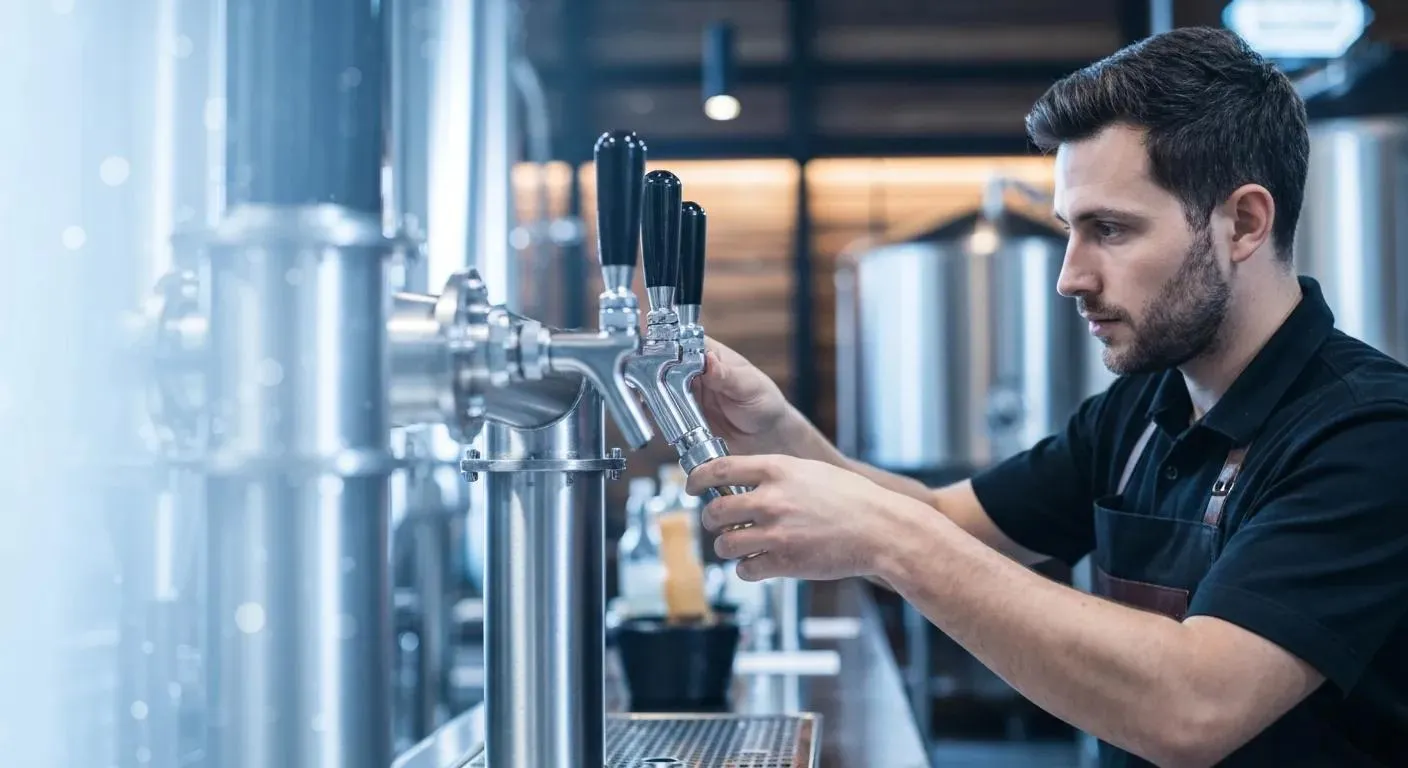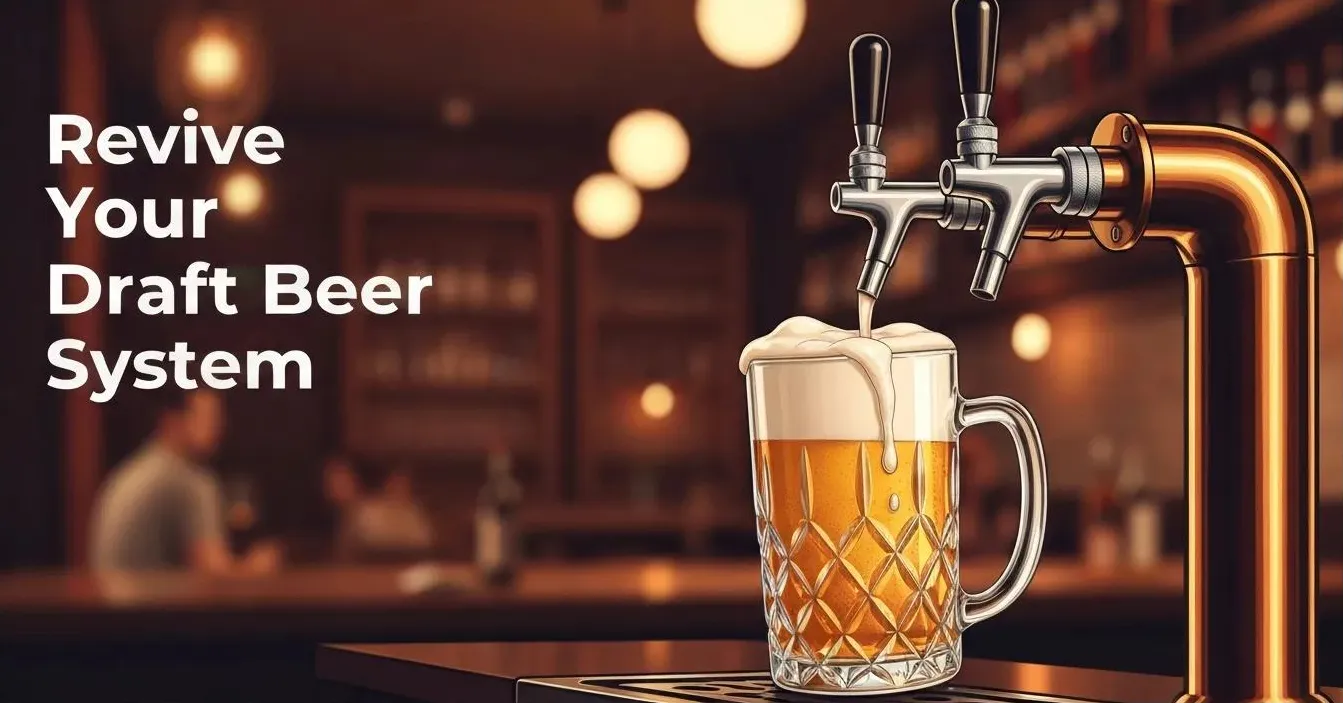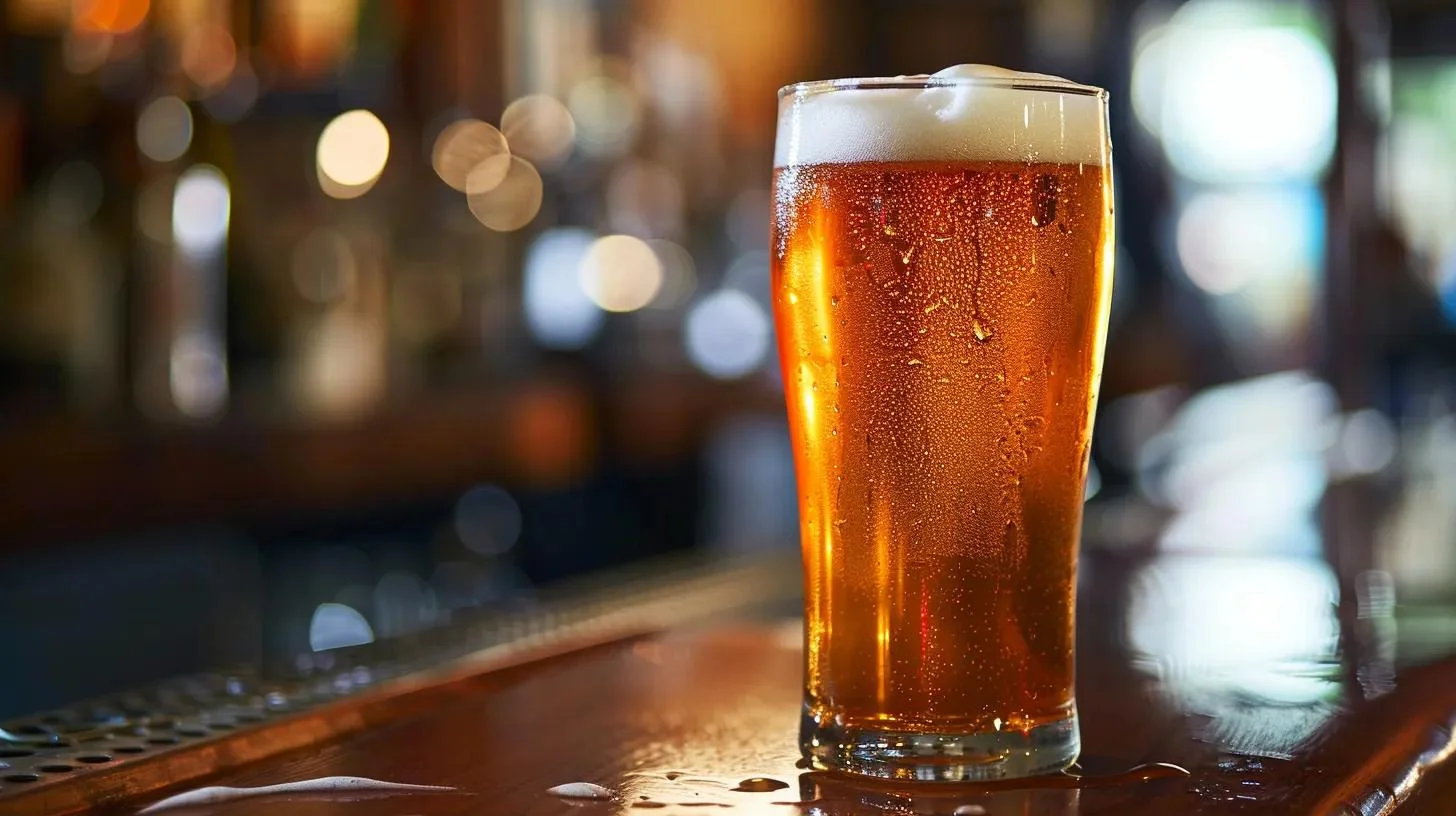Direct Draw Beer System: Essentials for Perfect Pub Pours

With the craft beer market remaining steady, the appeal of draft and beer dispensers is on the rise, favored by customers at bars and restaurants alike. The desire for a bounty of beer types, from stouts to IPAs, means that dispensing systems must be adaptable, ensuring a diverse selection is available without compromising the integrity of the beer's taste and carbonation are becoming more popular
The realm of beer dispensing hardware is diverse, boasting a trio of system types designed to suit and meet varying needs: the uncomplicated direct draw system, the air-cooled system, and the extensive remote or long draw system. Each presents unique benefits to fit specific service environments and enhance the overall experience of enjoying a cold draught beer.
Key Takeaways
- Draft beer systems are fundamental for delivering a variety of quality beers.
- There are three main types of beer dispensing systems, each with distinct advantages.
- Proper installation and maintenance are essential for optimal system performance and beverage quality.
What is a Draft Beer System?
A draft beer system is a network of components designed to deliver cold, refreshing beer from a keg to a dispensing faucet. These systems are a staple in bars, restaurants, and breweries, enabling the efficient serving of a variety of beers to customers. At its core, a draft beer system consists of several key elements: the keg, beer lines, a cold beer and dispensing faucet, and a cooling system. Together, these components work harmoniously to maintain the perfect temperature and pressure, ensuring that each pour is as crisp and flavorful as intended. Whether it’s a classic lager or a hoppy IPA, a well-maintained draft beer system is essential for preserving the integrity and taste of keg beer.
Direct Draw Beer Systems
Kegerator Setup
A kegerator integrates a refrigerator with a tap, allowing for chilled beer to be served directly from the beer keg. Generally consisting of a cooler, beer dispenser, draft beer tower connected to, faucet, keg coupler, and a CO2 tank, this appliance ensures a crisp pint. The faucet shank connects the faucet to the system, facilitating a seamless pour.
- Components: Faucet, Keg Coupler, CO2 Tank, Cooler, Draft Tower
- Ease of Use: User-friendly, ideal for quick setup and straightforward operation.

Wall-Mounted Taps
With a wall-mounted setup, the dispensing system is affixed to the wall, featuring a beer shank and tap handle. This configuration of dispensers typically includes a separate, cooler box, where the kegs are stored, and a regulator to manage gas pressure.
- Advantages: Space-saving, convenient for establishments with limited room.
- Setup: Beer Shank, Regulator, Wall Mount, Tap Handle
Benefits and Drawbacks
The foremost advantage of a direct draw system is its straightforwardness, offering a large and diverse range of keg beer with minimal training required for operation. However, it's important to recognize the system's limitations.
Pros:
- Simplicity in design and use
- Ideal for venues with a small selection of draft options
- Cost-effective with minimal beer loss during cleaning
Cons:
- It may not be suitable for larger establishments with an extensive beer selection
- Limited to serving close-range areas due to shorter beer runs
Chilled Draft Systems: Air-Based
Challenges with Air-Based Cooling
Air- circulated cold air-cooled draft systems typically offer a cost-effective solution for serving draft beer, especially favored in environments where space optimization is a concern. Despite their potential for space and cost savings, these systems grapple with the issue of maintaining a consistent cold temperature over long distances from the keg to the tap. Due to the extended travel of the beer through the lines, a heightened risk of temperature fluctuations arises.
The operation of commercial keg boxes these air-cooled systems relies on a combination of equipment: a forced air blower and an insulated conduit act together to propel and maintain chilled air in close contact with the beer lines, keeping the beer lines cold. This effort to preserve the cold chain from the keg’s interior storage area to the dispensing faucet is critical.
It’s noteworthy that the effectiveness of air cooling can lessen notably when managing multiple beers on tap simultaneously. Keeping beer cold and chilled ideally becomes more complex with more pathways requiring consistent air-cooling. Despite these hurdles, air-cooled systems have carved out their niche in the realm of beer dispensation, providing a suitable option where conventional setups may not be feasible.
Long Draw Remote Beer Systems
Advantages and Challenges of Extended Beer Distribution Systems
When venues such as sports bars or event centers need to deliver a variety of draft beers across vast spaces, extended draught beer networks are the solution. These systems rely on sophisticated equipment like glycol chillers hidden beer lines, filters, and beer pumps to ensure that beer travels from the keg to the faucet efficiently, despite the lengthy distance which can exceed a direct draw system’s range. The beer tower plays a crucial role in connecting the chilled beer lines to the faucet, ensuring optimal dispensing quality.
Advantages:
- Variety: Satisfies the demand for multiple beer selections in numerous locations.
- Flexibility: Ideal for areas without direct walk-in access or those wanting to serve in multiple areas.
- Quality: Maintains the integrity of the beer’s quality with a temperature-controlled flow.
Challenges:
- Initial Costs: The setup requires investment in specialized components such as glycol cooling systems and trunk lines.
- Maintenance: These systems demand consistent upkeep to manage CO2 levels, nitrogen, pressure, and refrigeration aspects.
- Complexity: System design can be complicated, involving numerous regulators, including a primary regulator, secondary regulator, and glycol power pack.

For venues that prioritize a versatile and high-capacity beer dispensing capability, the higher upfront investment in an extended draught bar beer dispenser system can provide long-term benefits, offering an extensive range of beer options and the ability to serve in various locations throughout the facility.
How Draft Beer Systems Work
Draft beer systems operate by utilizing a combination of CO2 and cold air to push beer from the keg through the beer lines to the dispensing faucet. Typically, the keg is stored in either a cooler box, walk-in cooler or a kegerator, maintaining a consistent temperature between 36-38°F. This cold environment is crucial for preserving the beer’s freshness and carbonation. The beer lines, which are insulated to prevent temperature fluctuations, carry the beer from the keg to the faucet with minimal beer waste. The beer dispensing faucet, equipped with a handle and spout, allows the bartender to control the flow of beer, ensuring a perfect pour every time. This meticulous process ensures that the draft beer served is always of optimal quality.
Delivering Draft Beer Perfection
Achieving draft beer perfection requires a blend of the right equipment, proper installation, and diligent maintenance. A direct draw system, known for its straightforward design, is ideal for establishments with limited space behind the bar. This system stores beer kegs together in the same unit as the beer dispenser, making it a compact and efficient solution. A forced cold air supply is used to maintain the temperature of the beer lines, ensuring that the beer is served at the perfect temperature. Regular cleaning and sanitizing of the beer lines and dispensing faucet are also crucial to prevent contamination and spoilage. By adhering to these practices, establishments can consistently deliver high-quality draft beer that delights customers.
Troubleshooting Common Issues
Common issues with draft beer systems, such as temperature fluctuations, beer waste, and contamination, can disrupt the quality of the beer served. To troubleshoot these problems, it’s essential to monitor the temperature of the beer keg located in storage space, the beer lines, and the dispensing faucet. Ensuring that the beer lines are properly insulated and that the dispensing faucet is clean and sanitized can help prevent contamination and spoilage. Regular maintenance, including cleaning and sanitizing the beer lines and dispensing faucet, is vital to keep the system running smoothly. By addressing these common issues proactively, establishments can maintain the integrity of their draft beer systems and ensure a consistently excellent beer-drinking experience.

Final Remarks on Maintaining Superior Draft Beer Systems
When managing a venue or restaurant that serves draft beer, it's imperative to choose a system that aligns with your business's scale, desired variety, and spatial layout. The right selection contributes significantly to not only safeguarding the quality and consistency of each served pint but also to enhancing customer satisfaction and potentially increasing profits.
- Direct Draw Systems: Ideal for compact spaces where the serving area is adjacent to the cooling source. Their operational simplicity is beneficial for sustaining cleanliness, ensuring a cost-effective solution, and providing that perfect pint in a more intimate setting.
- Air-Cooled Systems: A mid-range option that utilizes cold air to maintain beer temperature from cooler to tap. While not the premium choice, for budget-conscious establishments, these systems bridge the gap between affordability and maintaining draft beer quality.
- Remote/Long Draw Systems: Suited for larger venues that offer extensive draft selections, these intricate systems can maintain beer quality over long distances. Although installation and maintenance may be on the higher end, these systems can be pivotal in delivering variety and satisfaction to customers across various service points.
Selecting the appropriate draft system is fundamental in upholding the integrity of draught beer offerings. One should weigh the initial setup costs against the long-term benefits, including easy and efficient maintenance, to ensure a system that is not only economical but also excels in delivering a premium experience.
For establishments interested in adopting or upgrading their draft beer systems, considering these options in detail will lay the foundation for a successful beverage draft system.
Common Inquiries about Draft Beer Systems
Installation Expenses for Draft Beer Systems
When considering the cost of installation for a draft beer system, several factors come into play. Generally, the price can range from a couple of hundred dollars for a basic home setup to several thousand for a commercial-grade system. Cost elements include:
- The complexity of the system
- The number of taps
- The type of refrigeration
- Length and installation of beer lines
- Professional installation fees
Different Draft Beer Systems Explained
Draft beer systems vary, and key differences hinge on several aspects. For example:
- Glycol-cooled vs. air-cooled: Glycol-cooled systems are often used in commercial settings where beer lines run a longer distance, whereas air-cooled systems may suffice for shorter lines, like in-home bars.
- Direct draw vs. long draw systems: Direct draw is typically seen in kegerators and is a straightforward draft beer system ideal for settings with the keg close to the dispensing point, while long draw systems can transport beer over longer distances.
Essential Elements of Beer Lines in a Draft System
Every draft beer system comprises critical components such as:
- CO2 or Nitrogen tanks: Essential for pressurizing and dispensing beer.
- Regulators: To control gas pressure.
- Keg couplers: They connect the gas line and beer line to the keg.
- Beer lines/tubes: These carry beer from the keg to the tap.
- Faucet(s): The point of dispense where beer is poured.
Differences in Commercial and Residential Installations
Commercial draft beer system installations typically involve:
- More complex, larger capacity cooling and dispensing equipment.
- Longer beer runs require robust refrigeration like glycol chilling lines.
- Multiple taps and extensive customization options.
- Compliance with commercial building codes and health regulations.
Home setups, by contrast, are usually more straightforward and scaled-down.
Factors Affecting the Price of Commercial Beer Taps
The price of commercial beer tap systems can fluctuate based on:
- Scale of the System: Larger systems with more taps are costlier.
- Customization: Specialty taps and branded hardware may increase costs.
- Installation Complexity: Challenging installation environments or aesthetics like behind-the-bar custom builds.
- Regulatory Requirements: Compliant materials and installation methods can have financial implications.
Overview of Draft Beer Systems
Draft beer systems, often referred to as keg systems, are an essential component for serving beer directly from a keg. They are favored for their ability to preserve the beer's original flavor and carbonation levels, giving consumers a fresh-tasting beer experience. Here are some key elements that define these systems:
- Keg: A keg is the container that holds the beer. It's usually made of stainless steel and is the central component of a draft beer system.
- CO2 Tank: Carbon dioxide is used to pressurize the keg and push the beer through the system to maintain its carbonation and push it through the tap.
- Regulator: This device controls the pressure of the gas released from the CO2 tank, ensuring consistent pressure is maintained.
- Beer Lines are specialized hoses that transport beer from the keg to the tap. They are made of food-grade material that is resistant to beer's acidic nature.
- Faucet: The tap or faucet is where the beer is dispensed from the system to the glass.
- Refrigeration: It is crucial to keep the beer at an optimal temperature, which refrigeration units maintain throughout the system.
Draft beer systems exist in different types and configurations, such as direct-draw, air-cooled, and glycol-cooled systems. Each type caters to different setups and preferences. For instance, the direct-draw system is ideal for establishments where the keg is housed close to the serving area, thus requiring less intricate cooling mechanisms.
It is also important to maintain the system regularly to ensure the beer tastes as intended. This includes cleaning the lines to prevent build-up that can affect the flavor. The fundamentals of a draft beer system highlight the importance of balancing applied pressure and temperature to achieve the results and the perfect pour.
In summary, the design and maintenance of a draft beer system greatly influence the quality and taste of the draft beer served. Focusing on correctly setting up and maintaining the whole beer tap system and components walk in cooler system ensures a distinctly enjoyable beer-drinking experience.



